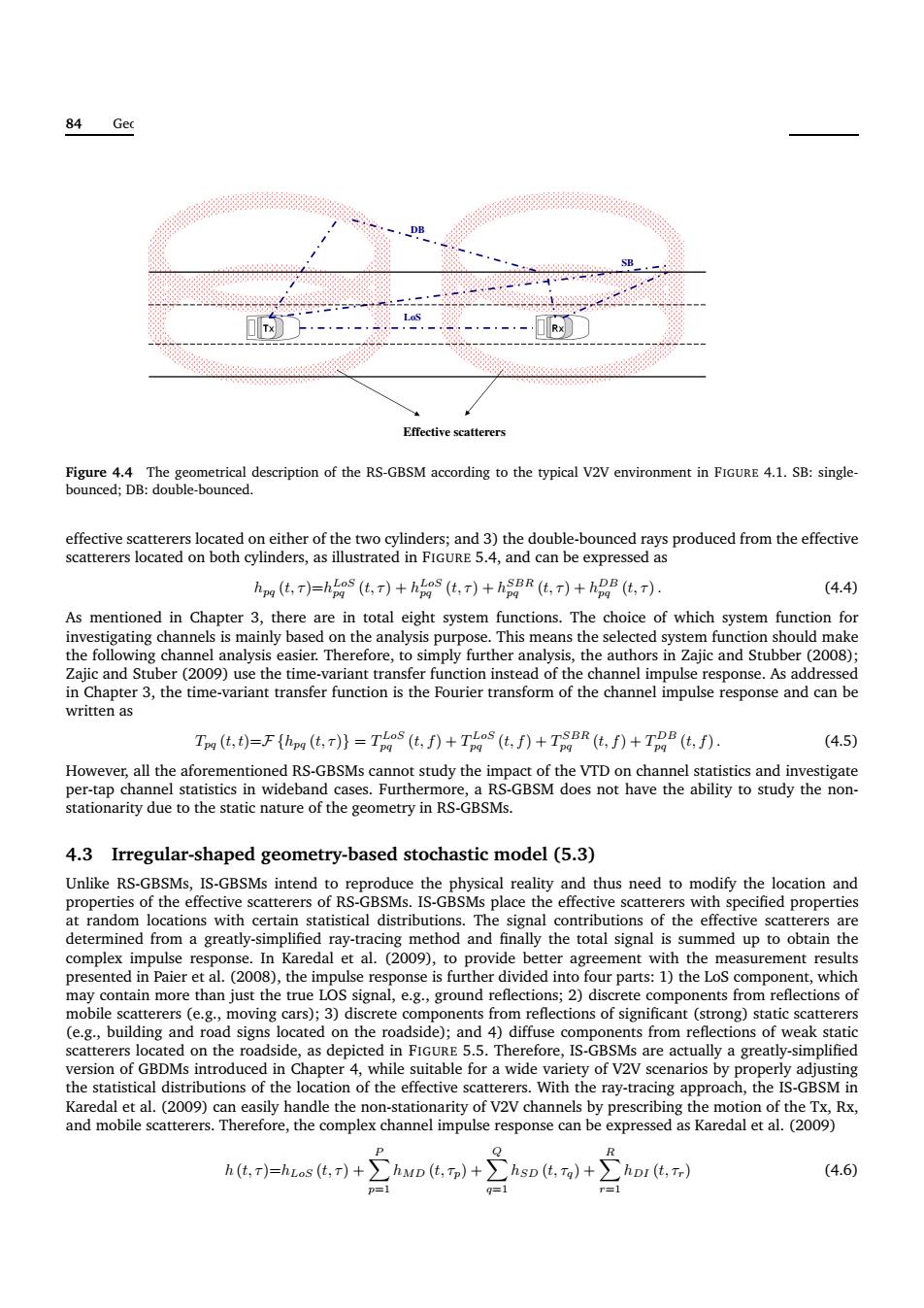正在加载图片...

84 Gec ·DB Effective scatterers and 3)the double.bounced r hpo (t,T)=htos (tT)+hies (tT)+hR (tT)+h (tT). (4.4) ing chant the ollo written as T,)=F{h化,}-Ts(化,f)+T(,)+TBR(,f)+TB(,f). (4.5) How all the afo study the 4.3 Irregular-shaped geometry-based stochastic model(5.3) certair e.In Karedal et al.(2009).to pr nent with the m presented in Paier et al.(2008),the impulse response is further divided into four parts:1)the LoS component,which (e.g..building and r oad sign cated on the adside);and 4)diffus compone nts from reflections of weak static the of the of the effective aterers.With the ray-racing approach,the BSM in (4.6 g=1 1 84 Geometry based stochastic channel modeling LoS SB DB Effective scatterers Figure 4.4 The geometrical description of the RS-GBSM according to the typical V2V environment in FIGURE 4.1. SB: singlebounced; DB: double-bounced. effective scatterers located on either of the two cylinders; and 3) the double-bounced rays produced from the effective scatterers located on both cylinders, as illustrated in FIGURE 5.4, and can be expressed as hpq (t, τ)=h LoS pq (t, τ) + h LoS pq (t, τ) + h SBR pq (t, τ) + h DB pq (t, τ). (4.4) As mentioned in Chapter 3, there are in total eight system functions. The choice of which system function for investigating channels is mainly based on the analysis purpose. This means the selected system function should make the following channel analysis easier. Therefore, to simply further analysis, the authors in Zajic and Stubber (2008); Zajic and Stuber (2009) use the time-variant transfer function instead of the channel impulse response. As addressed in Chapter 3, the time-variant transfer function is the Fourier transform of the channel impulse response and can be written as Tpq (t, t)=F {hpq (t, τ)} = T LoS pq (t, f) + T LoS pq (t, f) + T SBR pq (t, f) + T DB pq (t, f). (4.5) However, all the aforementioned RS-GBSMs cannot study the impact of the VTD on channel statistics and investigate per-tap channel statistics in wideband cases. Furthermore, a RS-GBSM does not have the ability to study the nonstationarity due to the static nature of the geometry in RS-GBSMs. 4.3 Irregular-shaped geometry-based stochastic model (5.3) Unlike RS-GBSMs, IS-GBSMs intend to reproduce the physical reality and thus need to modify the location and properties of the effective scatterers of RS-GBSMs. IS-GBSMs place the effective scatterers with specified properties at random locations with certain statistical distributions. The signal contributions of the effective scatterers are determined from a greatly-simplified ray-tracing method and finally the total signal is summed up to obtain the complex impulse response. In Karedal et al. (2009), to provide better agreement with the measurement results presented in Paier et al. (2008), the impulse response is further divided into four parts: 1) the LoS component, which may contain more than just the true LOS signal, e.g., ground reflections; 2) discrete components from reflections of mobile scatterers (e.g., moving cars); 3) discrete components from reflections of significant (strong) static scatterers (e.g., building and road signs located on the roadside); and 4) diffuse components from reflections of weak static scatterers located on the roadside, as depicted in FIGURE 5.5. Therefore, IS-GBSMs are actually a greatly-simplified version of GBDMs introduced in Chapter 4, while suitable for a wide variety of V2V scenarios by properly adjusting the statistical distributions of the location of the effective scatterers. With the ray-tracing approach, the IS-GBSM in Karedal et al. (2009) can easily handle the non-stationarity of V2V channels by prescribing the motion of the Tx, Rx, and mobile scatterers. Therefore, the complex channel impulse response can be expressed as Karedal et al. (2009) h (t, τ)=hLoS (t, τ) +X P p=1 hMD (t, τp) +X Q q=1 hSD (t, τq) +X R r=1 hDI (t, τr) (4.6)